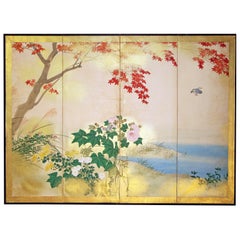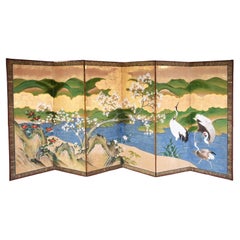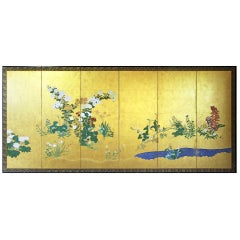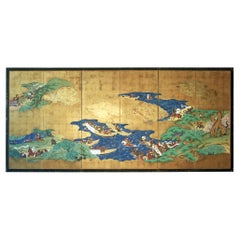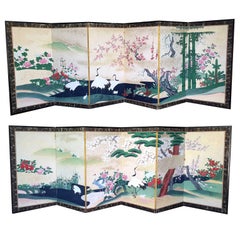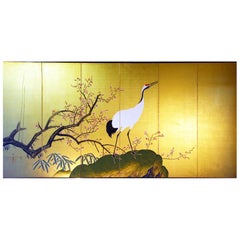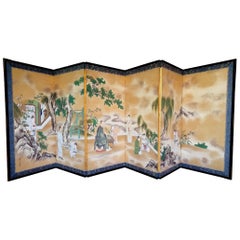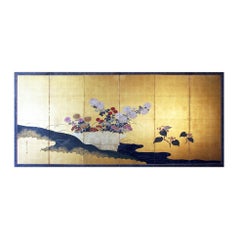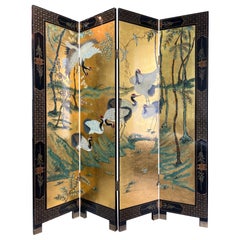Japanese Folding Screens
Mid-20th Century Japanese Showa Paintings and Screens
Paper
Antique Late 19th Century Unknown Meiji Paintings and Screens
Brass
Antique 18th Century Japanese Edo Paintings and Screens
Gold Leaf
Antique Early 19th Century Japanese Edo Paintings and Screens
Gold Leaf
Antique 1810s Japanese Japonisme Paintings and Screens
Brass
Antique Late 19th Century Japanese Meiji Paintings and Screens
Gold Leaf
Antique 17th Century Japanese Japonisme Paintings and Screens
Brass
Antique Early 19th Century Japanese Edo Paintings and Screens
Gold Leaf
Vintage 1970s Japanese Mid-Century Modern Paintings and Screens
Hardwood
Antique Early 19th Century Japanese Edo Paintings and Screens
Gold Leaf
Late 20th Century Japanese Screens and Room Dividers
Wood, Paper
Antique Early 19th Century Japanese Edo Paintings and Screens
Gold Leaf
Antique Late 19th Century Japanese Paintings and Screens
Paper
Vintage 1920s Japanese Taisho Paintings and Screens
Wood, Paper, Silk
Antique 19th Century Japanese Meiji Paintings and Screens
Metal
Antique Mid-19th Century Japanese Edo Paintings and Screens
Gold Leaf
20th Century Japanese Showa Paintings and Screens
Gold Leaf
Early 20th Century Japanese Taisho Paintings and Screens
Silk
Antique Late 18th Century Japanese Edo Paintings and Screens
Gold Leaf
Early 20th Century Japanese Taisho Screens and Room Dividers
Wood, Paper
Antique Late 17th Century Japanese Edo Paintings and Screens
Gold Leaf
Early 20th Century Japanese Screens and Room Dividers
Gold Leaf
Antique Early 19th Century Japanese Edo Paintings and Screens
Gold Leaf
Early 20th Century Japanese Taisho Paintings and Screens
Silk
Antique Early 18th Century Asian Edo Paintings and Screens
Gold Leaf
20th Century Japanese Paintings and Screens
Paper
Antique 19th Century Japanese Paintings and Screens
Silk, Paper
20th Century Japanese Paintings and Screens
Paper
20th Century Japanese Paintings and Screens
Paper
20th Century Japanese Paintings and Screens
Paper
20th Century Japanese Paintings and Screens
Paper
20th Century Japanese Meiji Paintings and Screens
Bronze
20th Century Japanese Showa Paintings and Screens
Paper
21st Century and Contemporary Japanese Paintings and Screens
Silk
21st Century and Contemporary Japanese Meiji Paintings and Screens
Brocade, Silk
20th Century Japanese Meiji Paintings and Screens
Bronze
21st Century and Contemporary Japanese Meiji Paintings and Screens
Silk, Brocade
20th Century Japanese Paintings and Screens
Silk
Antique 19th Century Japanese Paintings and Screens
Paper
Antique Late 19th Century Japanese Paintings and Screens
Paper
Early 20th Century Japanese Meiji Paintings and Screens
Paper
20th Century Japanese Paintings and Screens
Paper
20th Century Japanese Paintings and Screens
Paper
Antique 19th Century Japanese Paintings and Screens
Paper
Antique 19th Century Japanese Paintings and Screens
Paper
21st Century and Contemporary Japanese Meiji Paintings and Screens
Gold
Antique Early 19th Century Japanese Edo Paintings and Screens
Wood, Silk
21st Century and Contemporary Japanese Paintings and Screens
Silk, Brocade
20th Century Japanese Paintings and Screens
Paper
21st Century and Contemporary Japanese Paintings and Screens
Gold
Antique 19th Century Japanese Paintings and Screens
Paper
20th Century Japanese Paintings and Screens
Silk
Antique 19th Century Japanese Paintings and Screens
Paper
Antique 18th Century Japanese Edo Paintings and Screens
Gold Leaf
20th Century Japanese Showa Paintings and Screens
Gold Leaf
Mid-20th Century Japanese Showa Paintings and Screens
Silk, Paper
Antique 19th Century Japanese Paintings and Screens
Paper
Antique 19th Century Japanese Meiji Paintings and Screens
Gold Leaf
- 1
Japanese Folding Screens For Sale on 1stDibs
How Much are Japanese Folding Screens?
Finding the Right Asian Art And Furniture for You
From Japanese handmade earthenware pottery, originating circa 14,500 B.C. and adorned with elaborate corded patterns known as jōmon, to natural elm case pieces and storage cabinets built in Qing dynasty–era China to mid-century Thai rice-paper charcoal rubbings, antique and vintage Asian art and furniture make for wonderful additions to all kinds of contemporary interiors.
Eastern elements elevate any home’s decor. Introduce zen sensibility to your living room, dining room and bedroom with the neutral color palettes and the natural materials such as rattan, bamboo and elm that we typically associate with traditional Asian furniture. Decorative handwoven embroideries and textiles originating from India and elsewhere on the continent, which can be draped over a bed or sofa or used as a wall hanging, can be as practical as they are functional, just as you wouldn’t seek out Japanese room-divider screens — often decorated with paintings but constructed to be lightweight and mobile — merely for privacy.
With everything from blanket chests to lighting fixtures to sculptures and carvings, it’s easy to tastefully bring serenity to your living space by looking to the treasures for which the East has long been known.
For British-born furniture designer Andrianna Shamaris, the Japanese concept of beauty in imperfection isn’t limited to her Wabi Sabi collection. She embraces it in her New York City apartment as well. In the living area, for instance, she retained the fireplace’s original black marble while swathing its frame and the rest of the room in bright white.
“We left the fireplace very clean and wabi-sabi, so that it blended into the wall,” says Shamaris, who further appointed the space with a hand-carved antique daybed whose plush pillows are upholstered in antique textiles from the Indonesian island of Sumba.
In the growing antique and vintage Asian art and furniture collection on 1stDibs, find ceramics from China, antiquities from Cambodia and a vast range of tables, seating, dining chairs and other items from Japan, India and other countries.
- 1stDibs ExpertAugust 17, 2021Japanese screens are called Byōbu and are made from many panels with beautiful calligraphy and paintings. These folding screens can be a decorative and interesting way to separate rooms in a living space. Find a collection of Japanese screens for sale on 1stDibs.
- 1stDibs ExpertApril 5, 2022Japanese screen painting is the art of creating byōbu, or Japanese screens. Byōbu vary in subject matter and style. The screens are free-standing, portable and decorated with symbolic images or calligraphy. It is common to find byōbu in pairs with at least two panels. Shop a selection of byōbu on 1stDibs.
 Lotus GalleryMarch 17, 2021A Japanese low screen was traditionally used while seated upon the floor. The low screen would block wind and drafts, provide limited privacy, and are often decorated with seasonal themes.
Lotus GalleryMarch 17, 2021A Japanese low screen was traditionally used while seated upon the floor. The low screen would block wind and drafts, provide limited privacy, and are often decorated with seasonal themes.
Read More
Symbols of Happiness and Rebirth Adorn This Japanese Satsuma Bowl
Decorated with white cranes and the sought-after thousand-butterflies motif, the Meiji-period vessel offers both a celebration of traditional aesthetics and a clear reflection of the era’s appetite for exquisite export pieces.
Chicago’s Pagoda Red Has a Spirited Mix of Asian Antiques and Bold New Art
For 25 years, gallerist Betsy Nathan has leveraged her keen eye and key connections to bring a unique selection of rare finds to the market.
In L.A., Gallerist JF Chen Has Long Championed Eclectic Blue-Chip Design
Now working alongside his daughter Bianca, dealer Joel Chen has presented a most covetable array of antiques, art and contemporary creations for more than 40 years.
12 Calming Spaces Inspired by Japanese Design
From cherry-blossom-adorned walls paired with glamorous lighting to wood-paneled ceilings above checkerboard-patterned chairs, these 12 spaces seamlessly blend Eastern and Western aesthetics.
Rodrigo Rivero Lake’s Mexico City Showroom Is a Museum-Worthy Trove of Spanish Colonial and Asian Antiques
The dealer and curator has spent the past 50 years amassing a collection of exceptional art, furniture and architectural elements that trace the cultural influence of the Spanish empire from Europe to the Americas and beyond.
16 Refined Asian-Inspired Interiors
These spaces exemplify how Eastern elements elevate a home's decor.
